Cell organelles are specialized entities present inside a particular type of cell that performs a specific function.
There are various cell organelles, out of which, some are common in most types of cells like cell membranes, nucleus, and cytoplasm. However, some organelles are specific to one particular type of cell-like plastids and cell walls in plant cells.
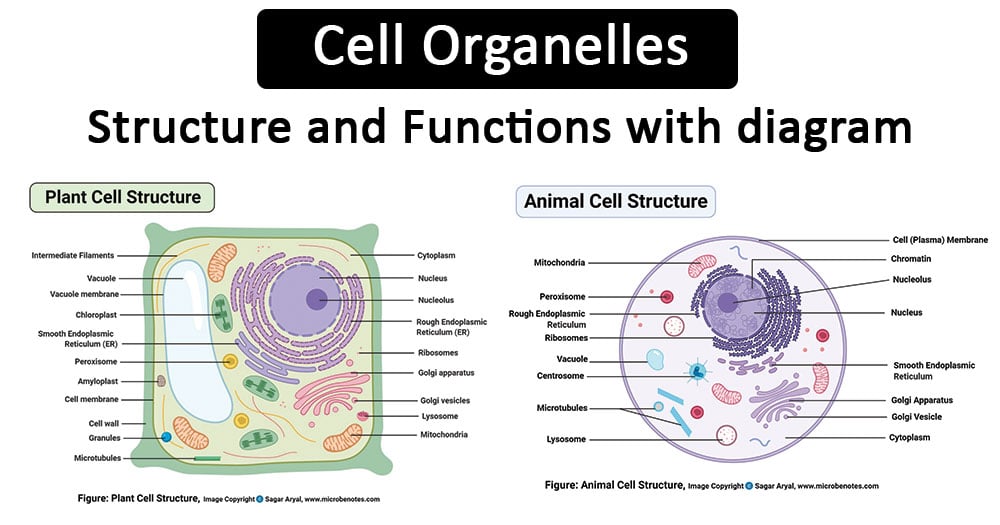
Interesting Science Videos
List of 24 Cell Organelles
- Cell membrane (Plasma membrane/ Plasmalemma)
- Cell Wall
- Centriole
- Cilia and Flagella
- Chloroplast
- Cytoplasm
- Cytoskeleton
- Endoplasmic Reticulum (ER)
- Endosomes
- Golgi Apparatus/ Golgi Complex/ Golgi Body
- Intermediate filaments
- Lysozyme
- Microfilaments
- Microtubules
- Microvilli
- Mitochondria
- Nucleus
- Peroxisomes
- Plasmodesmata
- Plastids
- Ribosomes
- Storage granules
- Vacuole
- Vesicles
Cell membrane (Plasma membrane/ Plasmalemma)
A plasma membrane is composed of lipids and proteins where the composition might fluctuate based on fluidity, external environment, and the different stages of development of the cell.
Structure of Cell Membrane
- Structurally, it consists of a phospholipid bilayer along with two types of proteins viz. embedded proteins and peripheral proteins that function in providing shape and allowing the movement of particles in and out of the cell.
- The most abundant lipid which is present in the cell membrane is a phospholipid that contains a polar head group attached to two hydrophobic fatty acid tails.
- The embedded proteins act as channels for the transfer of particles across the cell with some proteins acting as receptors for the binding of various components.
- The peripheral proteins function as to provide fluidity as well as mechanical support to the structure of the cell.
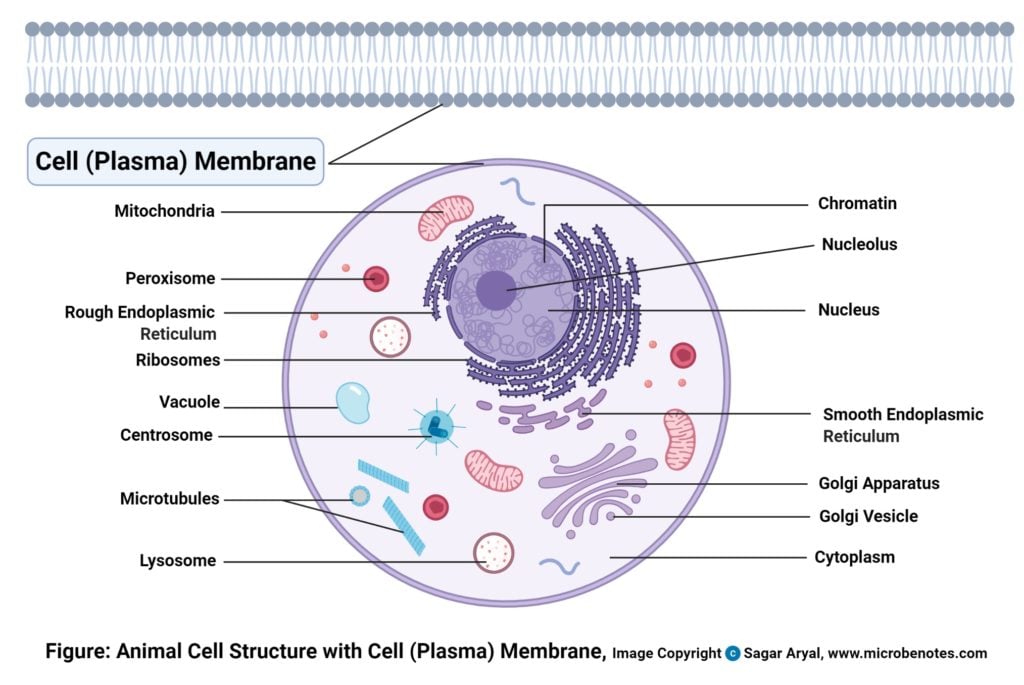
Functions of Cell Membrane
- The cell membrane provides mechanical support that facilities the shape of the cell while enclosing the cell and its components from the external environment.
- It regulates what can be allowed to enter and exit the cell through channels, acting as a semi-permeable membrane, which facilities the exchange of essential compounds required for the survival of the cell.
- It generates and distributes signals in and outside of the cell for the proper functioning of the cell and all the organelles.
- It allows the interaction between cells required during tissue formation and cell fusion.
Cell Wall
An additional non-living layer present outside the cell membrane in some cells that provides structure, protection, and filtering mechanism to the cell is the cell wall.
Structure of Cell Wall
- In a plant cell, the cell wall is made up of cellulose, hemicellulose, and proteins while in a fungal cell, it is composed of chitin.
- A cell wall is multilayered with a middle lamina, a primary cell wall, and a secondary cell wall.
- The middle lamina contains polysaccharides that provide adhesion and allow binding of the cells to one another.
- After the middle lamina is the primary cell wall which is composed of cellulose. The last layer, which is not always present, is the secondary cell wall made of cellulose and hemicellulose.
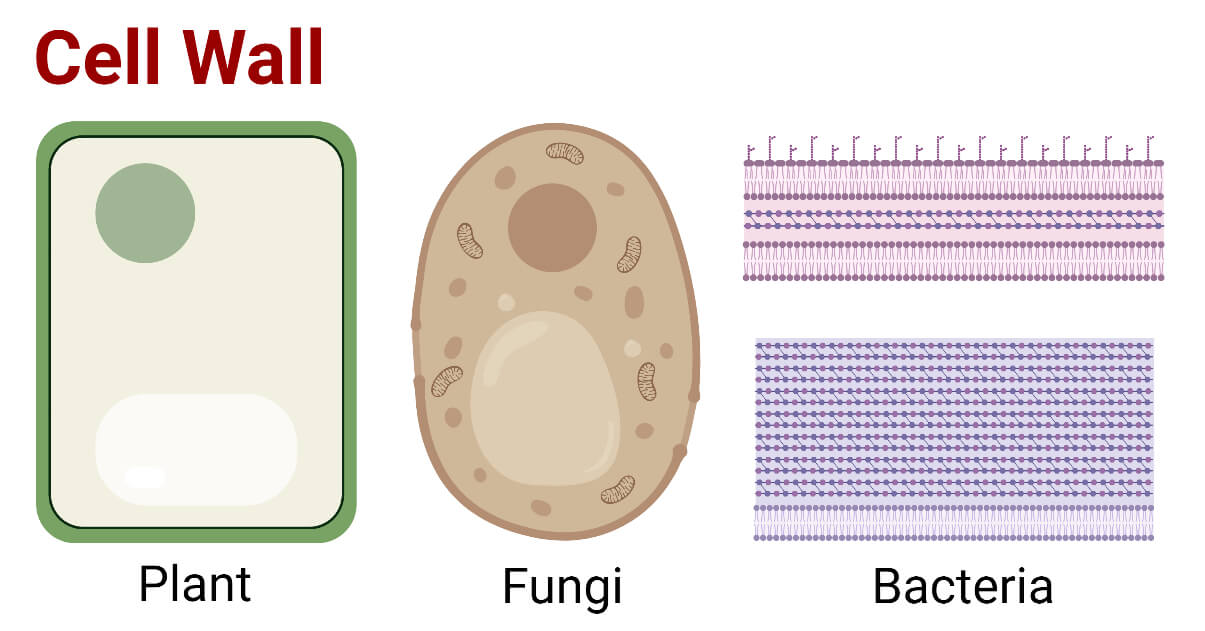
Functions of Cell Wall
- The critical function of the cell wall is protecting and maintaining the shape of the cell. It also helps the cell withstand the turgor pressure of the cell.
- It initiates cell division by providing signals to the cell and allows the passage of some molecules into the cell while blocking others.
Centriole
Centrioles are tubular structures mostly found in eukaryotic cells which are composed mainly of the protein tubulin.
Structure of Centriole
- A centriole consists of a cylindrical structure made with nine triplets microtubules that surround the periphery of the centriole while the center has a Y-shaped linker and a barrel-like structure that stabilizes the centriole.
- Another structure called cartwheel is present in a centriole which is made up of a central hub with nine spokes/filaments radiating from it. Each of these filaments/spokes is connected to the microtubules through a pinhead.
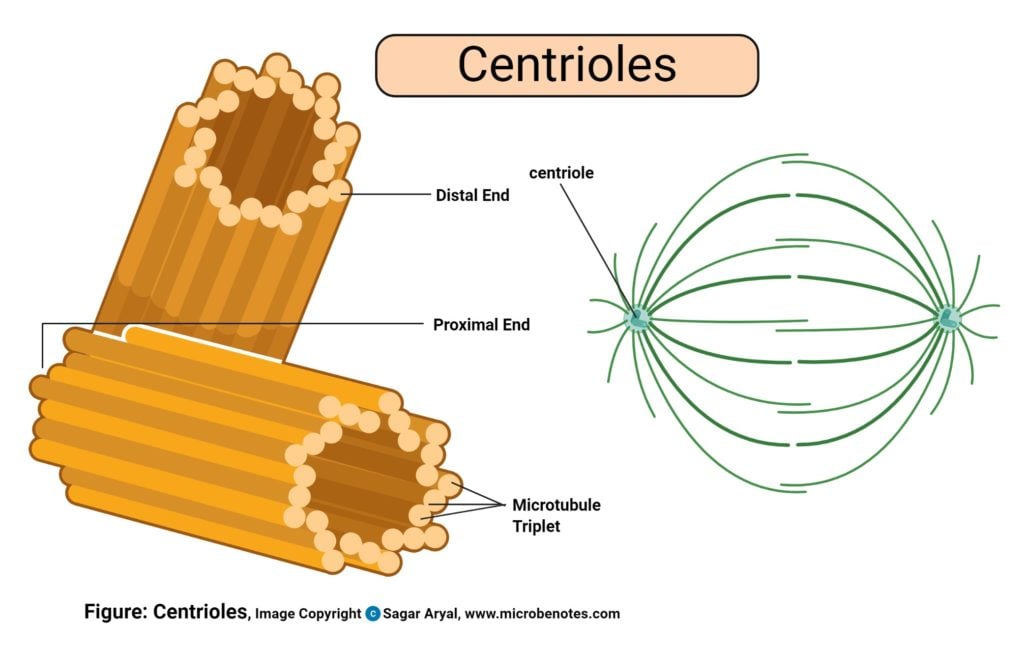
Functions of Centriole
- During cell division, centrioles have a crucial role in forming spindle fibers which assist the movement of chromatids towards their respective sides.
- They are involved in the formation of cilia and flagella.
Cilia and Flagella
Cilia and Flagella are tiny hair-like projections from the cell made of microtubules and covered by the plasma membrane.
Structure of Cilia and Flagella
- Cilia are hair-like projections that have a 9+2 arrangement of microtubules with a radial pattern of 9 outer microtubule doublet that surrounds two singlet microtubules. This arrangement is attached to the bottom with a basal body.
- Flagella is a filamentous organelle, the structure of which, is different in prokaryotes and eukaryotes.
- In prokaryotes, it is made up of the protein called flagellin wrapped around in a helical manner creating a hollow structure at the center throughout the length.
- In eukaryotes, however, the protein is absent and the structure is replaced with microtubules.
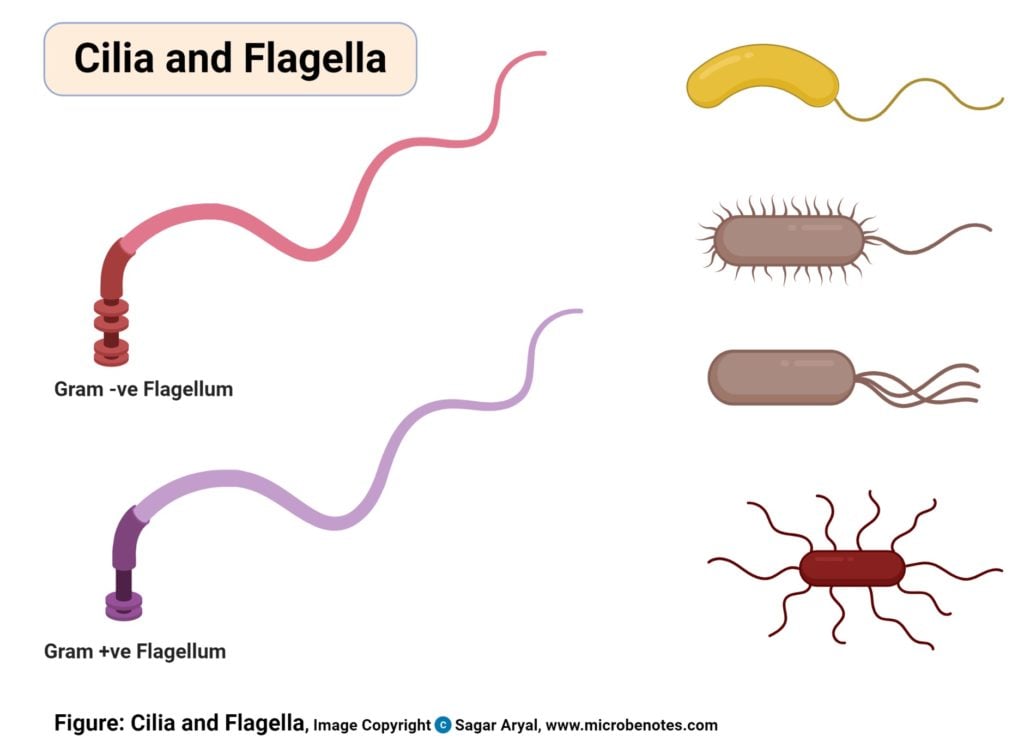
Functions of Cilia and Flagella
- The most critical role of cilia and flagella is movement. These are responsible for the movement of the organisms as well as for the movement of various particles present around the organisms.
- Some cilia present in some particular organs may have the function of sense. The cilium in the blood vessels, which helps in controlling the flow of blood is an example.
Chloroplast
A chloroplast is a type of plastic that is involved in photosynthesis in plants and algae. Chloroplast contains an essential pigment called chlorophyll necessary to trap sunlight for the production of glucose.
Structure of Chloroplast
- It is a double-membraned structure with its own DNA which is inherited from the previous chloroplast.
- These are usually lens-shaped with shape and number varying according to cells. They have an outer membrane, an inner membrane, and a thylakoid membrane that enclosed the gel-like matric called the stroma.
- The outer and inner membrane is porous and allows transport of materials while the stroma contains DNA, chloroplast ribosomes, proteins, and starch granules.
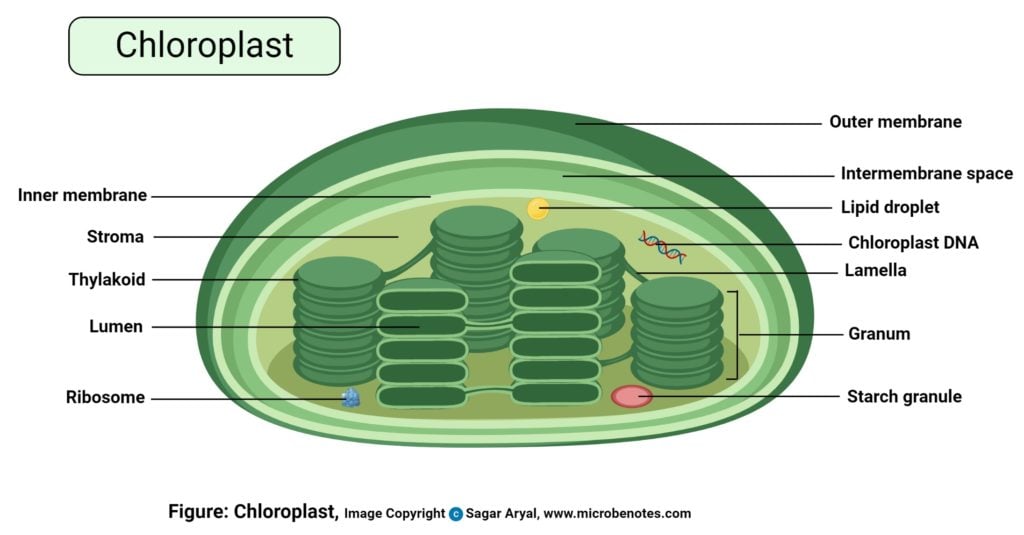
Functions of Chloroplast
- The chloroplast is the primary center for light-dependent and light-independent reactions during photosynthesis.
- Different proteins present in chlorophyll are involved in the regulation of photorespiration.
Cytoplasm
Cytoplasm refers to everything present inside the cell except the nucleus.
Structure of Cytoplasm
- The cytoplasm consists of a cytosol; a gel-like substance that contains other matter; cell organelles; smaller cell-like bodies bound by separate membranes; and cytoplasmic inclusions; insoluble molecules that store energy and are not surrounded by any layer.
- The cytoplasm is colorless and has about 80% water along with various nutrients required for the cell.
- It is known to have the properties of both viscous matter as well as elastic matter. Under its elasticity, cytoplasm helps in the movement of materials inside the cell by a process termed cytoplasmic streaming.
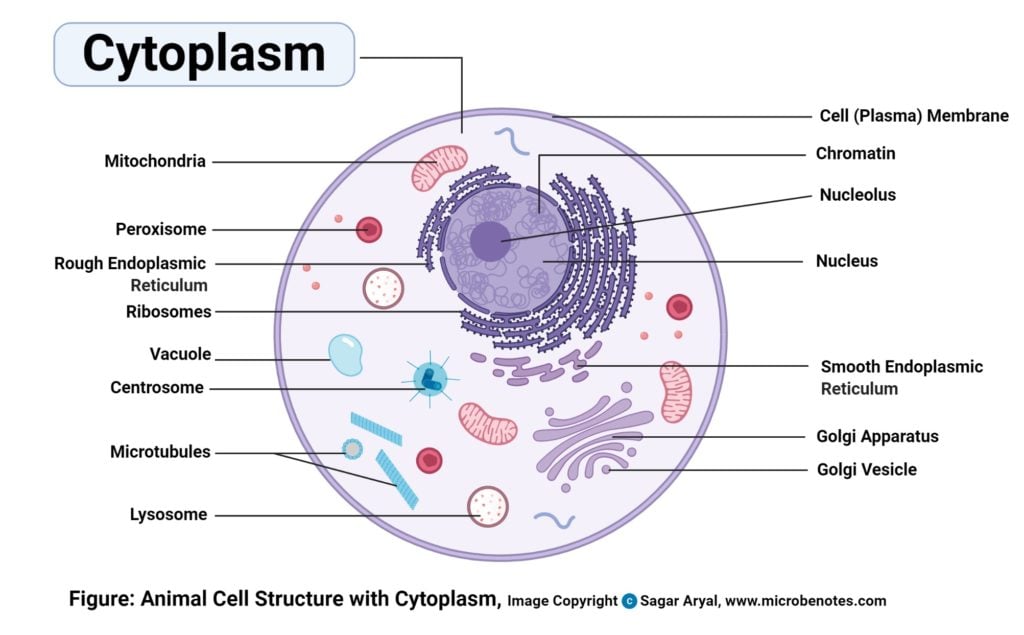
Functions of Cytoplasm
- Most of the vital cellular and enzymatic reactions like cellular respiration and translation of mRNA into proteins occur in the cytoplasm.
- It acts as a buffer and protects genetic materials as well as other organelles from damage due to collision or change in the pH of the cytosol.
- The process called cytoplasmic streaming helps in the distribution of various nutrients and facilitates the movement of cell organelles within the cell.
Cytoskeleton
A number of fibrous structures are present in the cytosol that helps give shape to the cell while supporting cellular transport.
Structure of Cytoskeleton
- Around three different classes of fibers make up the cytoskeleton which is: microtubules, microfilaments, and intermediate filaments.
- These are separated based on a protein present in them.
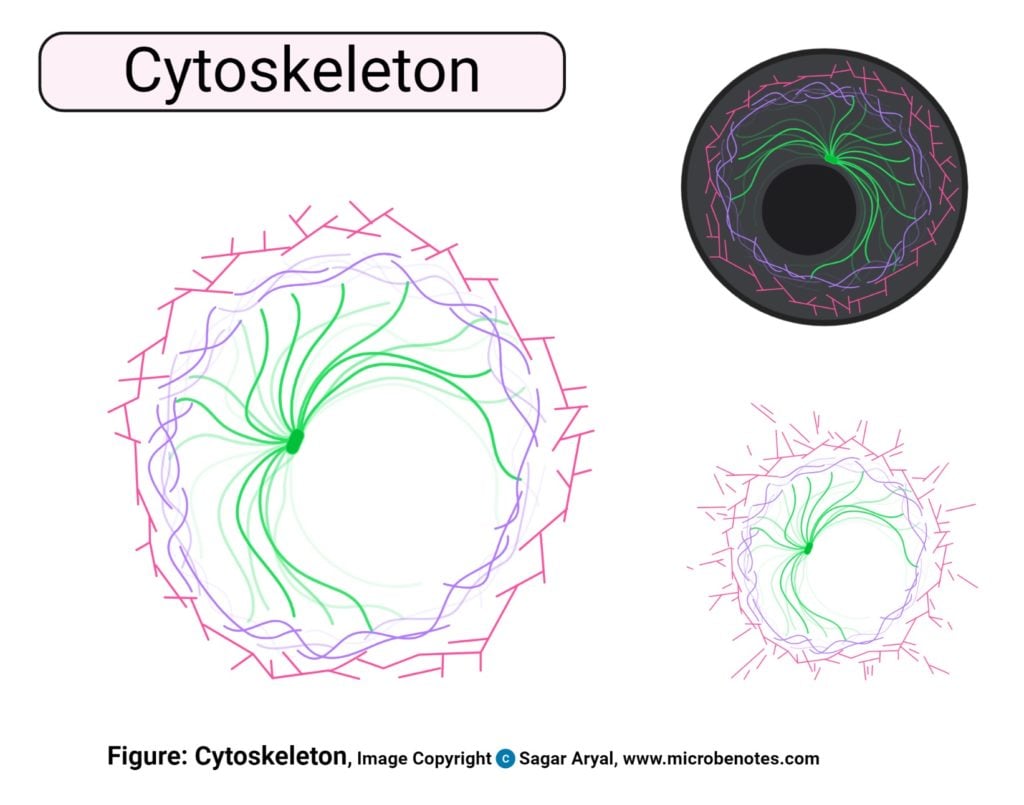
Functions of Cytoskeleton
- The critical function of the cytoskeleton is to provide shape and mechanical support to the cell against deformation.
- It allows the expansion and contraction of the cell which assists in the movement of the cell.
- It is also involved in the intracellular and extracellular transport of materials.
Endoplasmic Reticulum (ER)
Endoplasmic Reticulum (ER) is present as an interconnection of tubules that are connected to the nuclear membrane in eukaryotic cells.
There are two types of ER based on the presence or absence of ribosomes on them:
- Rough ER (RER) with ribosomes attached on the cytosolic face of Endoplasmic Reticulum and thus is involved in protein synthesis
- Smooth ER (SER) lacks ribosomes and has a function during lipid synthesis.
Structure of Endoplasmic Reticulum (ER)
- Endoplasmic Reticulum exists in three forms viz. cisternae, vesicles, and tubules.
- Cisternae are sac-like flattened, unbranched structures that remain stacked one on top of another.
- Vesicles are spherical structures that carry proteins throughout the cell.
- Tubules are tubular branched structures forming a connection between cisternae and vesicles.
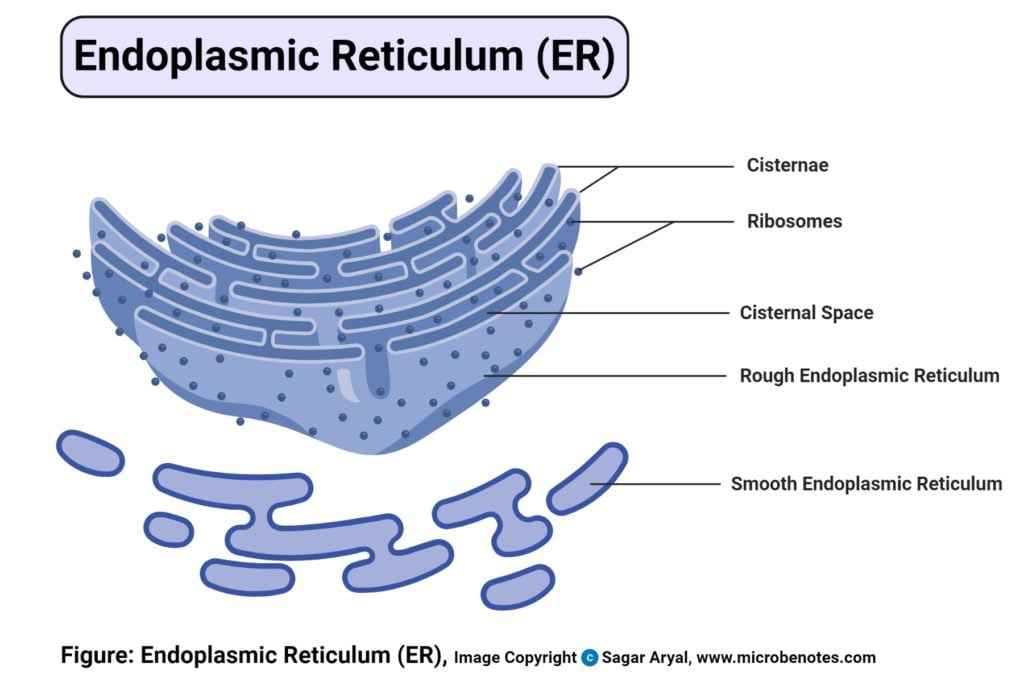
Functions of Endoplasmic Reticulum (ER)
- ER contains many of the enzymes required for several metabolic processes, and the surface of the ER is essential for other operations like diffusion, osmosis, and active transport.
- One of the crucial functions of ER is the synthesis of lipids like cholesterol and steroids.
- Rough ER allows for the modification of polypeptides emerging out of the ribosomes to prepare secondary and tertiary structures of the protein.
- ER also synthesizes various membrane proteins and has a crucial role in preparing the nuclear envelope after cell division.
Endosomes
Endosomes are membrane-bound compartments within a cell originating from the Golgi network
Structure of Endosomes
- There are different types of endosomes based on morphology and the time it takes for the endocytosed materials to reach them.
- The early endosomes are made with the tubular-vesicular network while the late endosomes lack tubules but contain many close-packed intraluminal vesicles. The recycling endosomes are found with microtubules and are mainly composed of tubular structures.
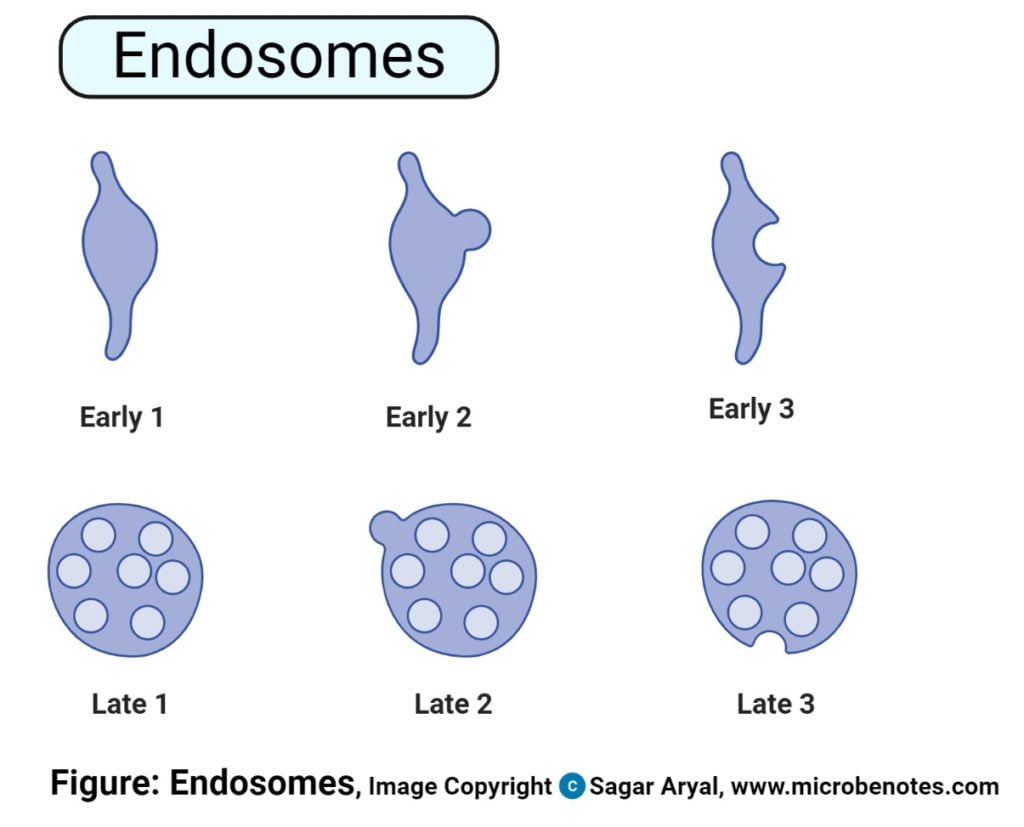
Functions of Endosomes
- Endosomes allow the sorting and delivery of internalized materials from the cell surface and transport of materials to the Golgi or the lysosomes.
Golgi Apparatus/ Golgi Complex/ Golgi Body
The Golgi Apparatus is the cell organelle mostly present in eukaryotic cells which is responsible for the packaging of macromolecules into vesicles so that they can be sent out to their site of action.
Structure of Golgi Apparatus
- The structure of the Golgi Complex is pleomorphic; however, it typically exists in three forms, i.e. cisternae, vesicles, and tubules.
- The cisternae, which is the smallest unit of the Golgi Complex, has a flattened sac-like structure that is arranged in bundles in a parallel fashion.
- Tubules are present as tubular and branched structures that radiate from the cisternae and are fenestrated at the periphery.
- Vesicles are spherical bodies that are divided into three groups as transitional vesicles, secretory vesicles, and clathrin-coated vesicles.

Functions of Golgi Apparatus
- Golgi Complex has an essential purpose of directing proteins and lipids to their destination and thus, act as the “traffic police” of the cell.
- They are involved in the exocytosis of various products and proteins like zymogen, mucus, lactoprotein, and parts of the thyroid hormone.
- Golgi Complex is involved in the synthesis of other cell organelles like a cell membrane, lysozymes, among others.
- They are also involved in the sulfation of various molecules.
Intermediate filaments
The third class of filament that makes up the cytoskeleton is the intermediate filaments. They are designated as intermediate filaments because of the intermediate diameter of the filaments as compared to microfilaments and myosin proteins.
Structure of Intermediate filaments
- Intermediate filaments contain a family of related proteins.
- The individual filaments are coiled around each other in a helical structure called coiled-coil structure.
Functions of Intermediate filaments
- Intermediate filaments contribute to the structural integrity of a cell while playing a crucial role in holding tissues of various organs like the skin.
Lysozyme
Lysozymes are membrane-bound organelles that occur in the cytoplasm of animal cells. These organelles contain an array of hydrolytic enzymes required for the degradation of various macromolecules.
There are two types of lysozymes:
- Primary lysozyme containing hydrolytic enzymes like lipases, amylases, proteases, and nucleases.
- Secondary lysozyme formed by the fusion of primary lysozymes containing engulfed molecules or organelles.
Structure of Lysozyme
- The shape of lysozymes is irregular or pleomorphic; however, mostly, they are found in spherical or granular structures.
- Lysozymes are surrounded by a lysosomal membrane that contains the enzymes within the lysosome and protects the cytosol with the rest of the cell from the harmful action of the enzymes.

Functions of Lysozyme
- These organelles are responsible for intracellular digestion where the larger macromolecules are degraded into smaller molecules with the help of enzymes present in them.
- Lysozymes also perform the critical function of the autolysis of unwanted organelles within the cytoplasm.
- Besides these, the lysosome is involved in various cellular processes, including secretion, plasma membrane repair, cell signaling, and energy metabolism.
Microfilaments
Microfilaments are a part of the cytoskeleton of a cell made up of actin protein in the form of parallel polymers. These are the smallest filaments of the cytoskeleton with high rigidity and flexibility, providing strength and movement to the cell.
Structure of Microfilaments
- The filaments are present either in cross-linked forming networks or as bundles. The chains of protein remain twisted around each other in a helical arrangement.
- One of the polar ends of the filament is positively charged and barbed, whereas the other end is negatively charged and pointed.
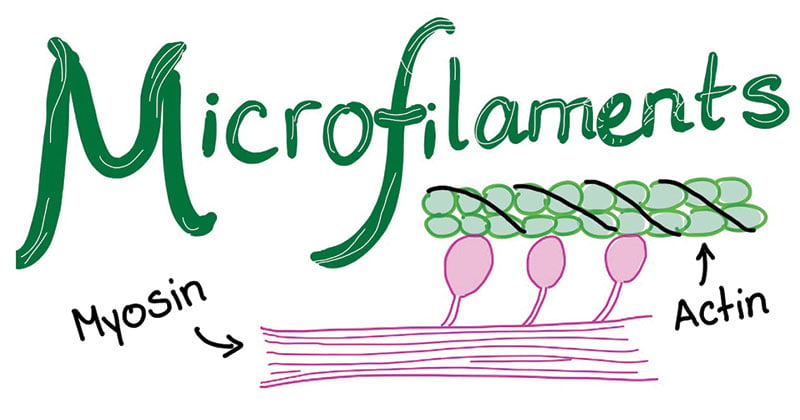
Functions of Microfilaments
- It generates the strength for the structure and movement of the cell in association with myosin protein.
- They help in cell division and are involved in the products of various cell surface projections.
Microtubules
Microtubules are also a part of the cytoskeleton differing from microfilaments in the presence of tubulin protein
Structure of Microtubules
- They are long hollow, beaded tubular structures of a diameter of about 24nm.
- The wall of the microtubules consists of globular subunits present at a helical array of a and b tubulin.
- Similar to microfilaments, the ends of microtubules also have a defined polarity with one end being positively charged while the other being negatively charged.
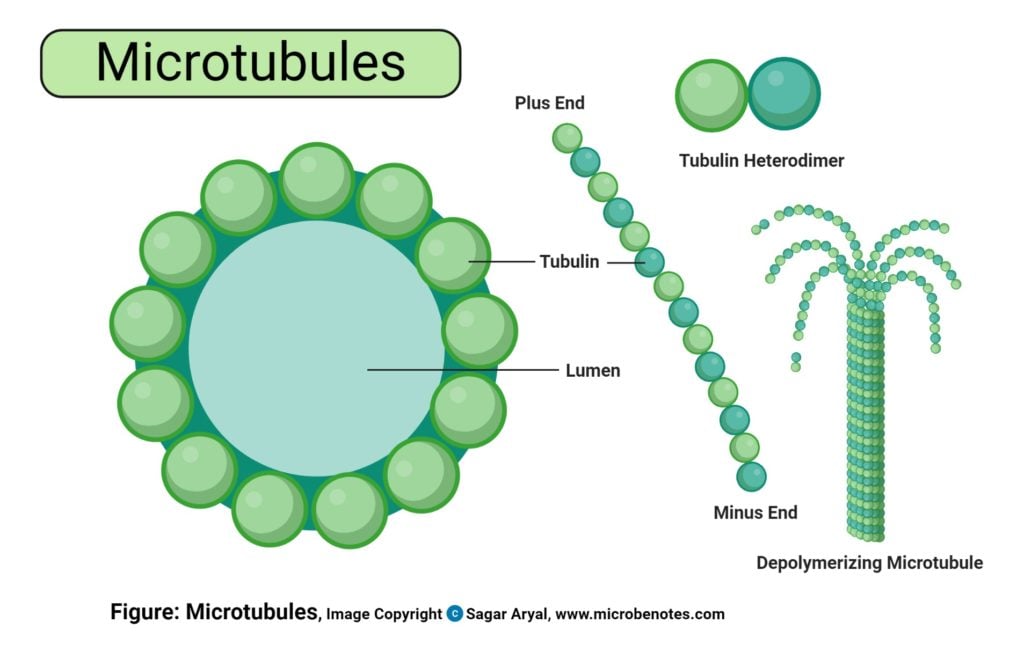
Functions of Microtubules
- As a part of the cytoskeleton, they provide shape and movement to the cell.
- Microtubules facilitate the movement of other cell organelles within the cell through binding proteins.
Microvilli
Microvilli are tiny finger-like structures that project on or out of the cells. These exist either on their own or in conjunction with villi.
Structure of Microvilli
- Microvilli are bundles of protuberances loosely arranged on the surface of the cell with little or no cellular organelles.
- These are surrounded by a plasma membrane enclosing cytoplasm and microfilaments.
- These are bundles of actin filaments bound by fimbrin, villin, and epsin.
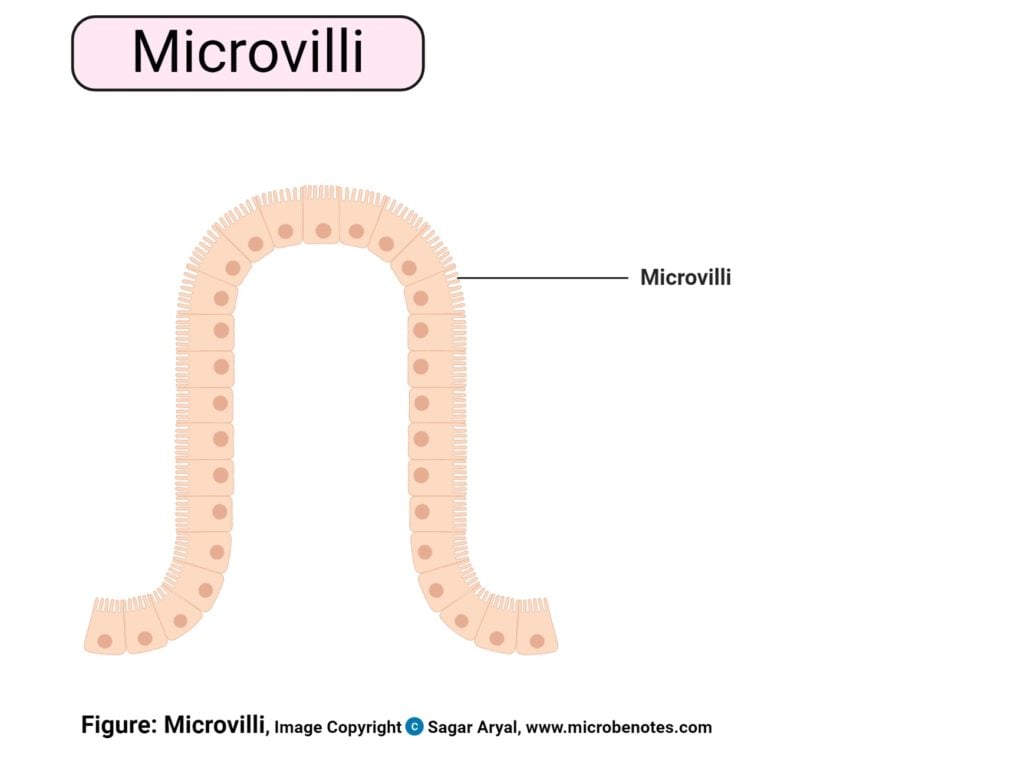
Functions of Microvilli
- Microvilli increase the surface area of the cell, thus, enhancing the absorption and secretion functions.
- The membrane of microvilli is packed with enzymes that allow the break down of larger molecules into smaller allowing more effective absorption.
- Microvilli act as an anchoring agent in white blood cells and in sperms during fertilization.
Mitochondria
Mitochondria are double membrane-bound cell organelles responsible for the supply and storage of energy for the cell. The oxidation of various substrates in the cell to release energy in the form of ATP (Adenosine Triphosphate) is the primary purpose of mitochondria.
Structure of Mitochondria
- A mitochondrion contains two membranes with the outer layer being smooth while the inner layer is marked with folding and finger-like structures called cristae.
- The inner mitochondrial membrane contains various enzymes, coenzymes, and components of multiple cycles along with pores for the transport of substrates, ATP, and phosphate molecules.
- Within the membranes is a matrix that contains various enzymes of metabolic processes like Kreb’s cycle.
- In addition to these enzymes, mitochondria are also home to single or double-stranded DNA called mtDNA that is capable of producing 10% of the proteins present in the mitochondria.
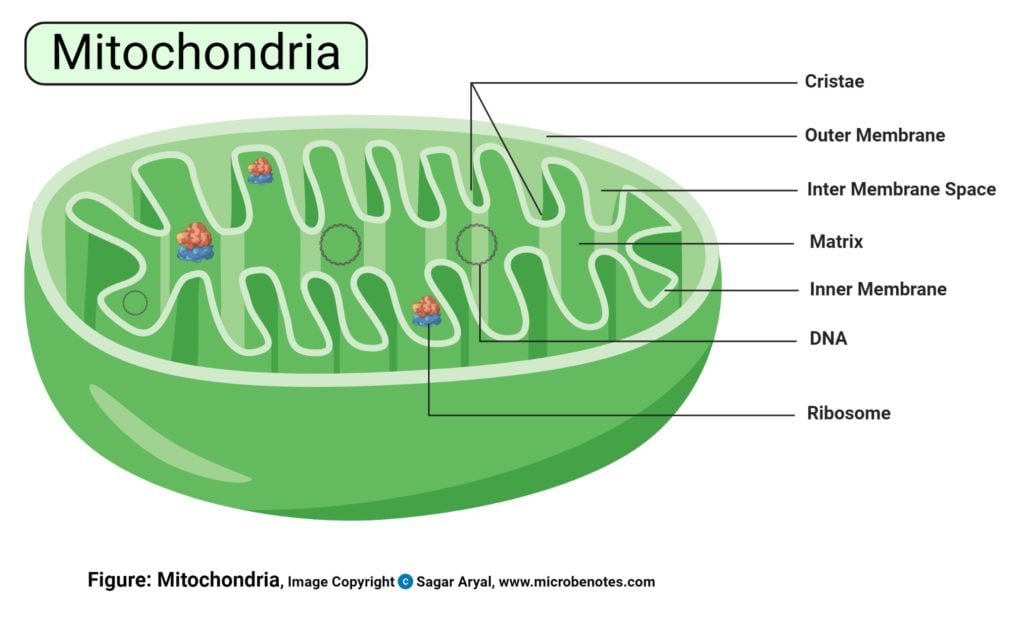
Functions of Mitochondria
- The primary function of mitochondria is the synthesis of energy in the form of ATP required for the proper functioning of all the cell organelles.
- Mitochondria also help in balancing the amount of Ca+ ions within the cell and assists the process of apoptosis.
- Different segments of hormones and components of blood are built within mitochondria.
- Mitochondria in the liver have the ability to detoxify ammonia.
Nucleus
The nucleus is a double membrane-bound structure responsible for controlling all cellular activities as well as a center for genetic materials, and it’s transferring. It is one of the large cell organelles occupying 10% of the total space in the cell. It is often termed the “brain of the cell” as it provides commands for the proper functioning of other cell organelles. A nucleus is clearly defined in the case of a eukaryotic cell; however, it is absent in prokaryotic organisms with the genetic material distributed in the cytoplasm.
Structure of Nucleus
- Structurally, the nucleus consists of a nuclear envelope, chromatin, and nucleolus.
- The nuclear envelope is similar to the cell membrane in structure and composition. It has pores that allow the movement of proteins and RNA in and outside the nucleus. It enables the interaction with other cell organelles while keeping nucleoplasm and chromatin within the envelope.
- The chromatin in the nucleus contains RNA or DNA along with nuclear proteins, as genetic material that is responsible for carrying the genetic information from one generation to another. It is present in a sense and compact structure which might be visible as a chromosome under powerful magnification.
- The nucleolus is like a nucleus within the nucleus. It is a membrane-less organelle that is responsible for the synthesis of rRNA and the assembly of ribosomes required for protein synthesis.
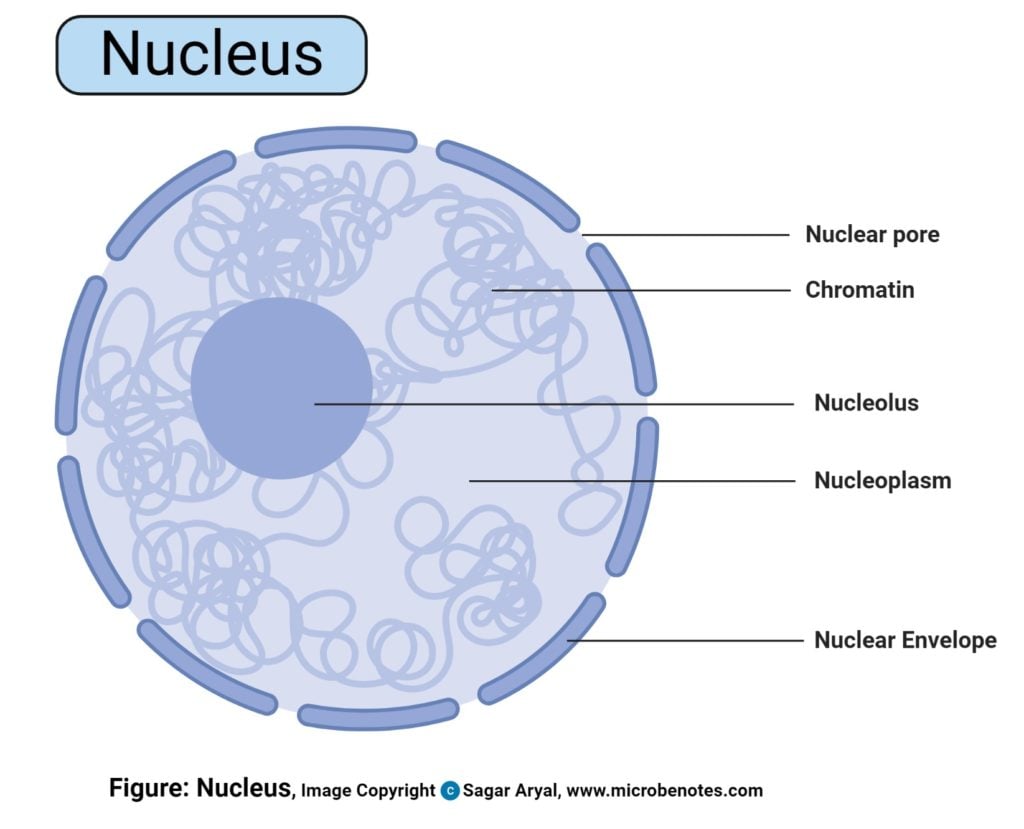
Functions of Nucleus
- The nucleus is responsible for storage as well as the transfer of genetic materials in the form of DNA or RNA.
- It aids in the process of transcription by the synthesis of mRNA molecules.
- The nucleus controls the activity of all other organelles while facilitating processes like cell growth, cell division, and the synthesis of proteins.
Peroxisomes
Peroxisomes are oxidative membrane-bound organelles found in the cytoplasm of all eukaryotes. The name is accredited due to their hydrogen peroxide generating and removing activities.
Structure of Peroxisomes
- Peroxisome consists of a single membrane and granular matrix scattered in the cytoplasm.
- They exist either in the form of interconnected tubules or as individual peroxisomes.
- The compartments within every peroxisome allow the creation of optimized conditions for different metabolic activities.
- They consist of several types of enzymes with major groups being urate oxidase, D-amino acid oxidase, and catalase.
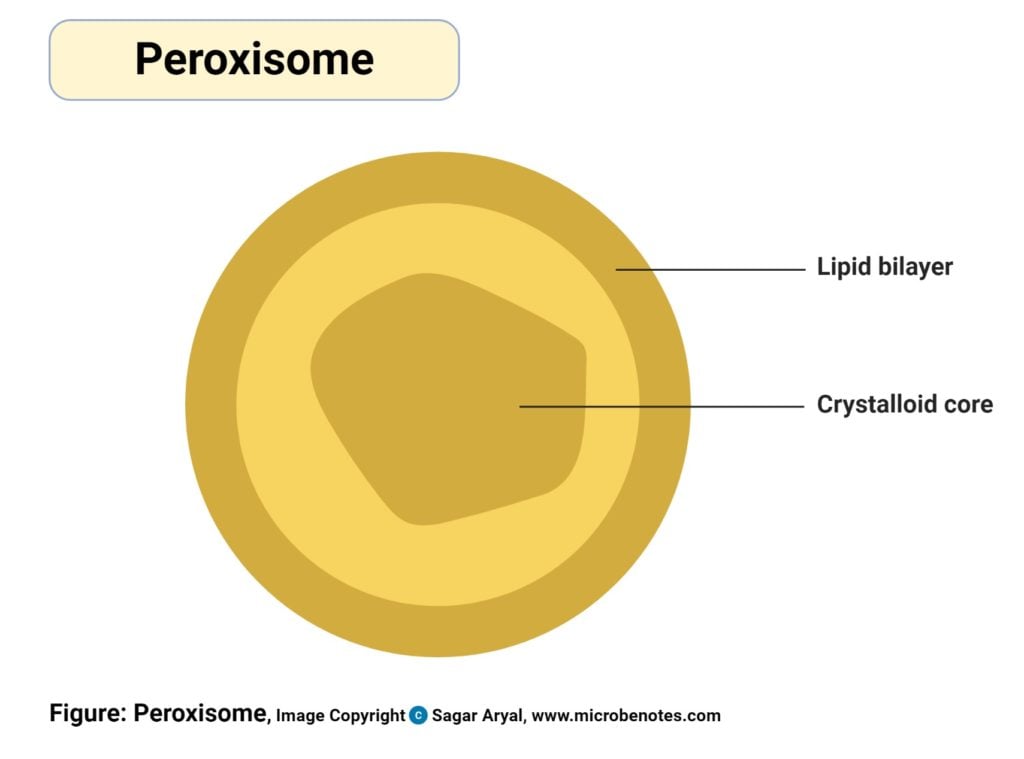
Functions of Peroxisomes
- Peroxisomes are involved in the production and elimination of hydrogen peroxide during biochemical processes.
- Oxidation of fatty acids takes place within peroxisomes.
- Additionally, peroxisomes are also involved in the synthesis of lipid-like cholesterol and plasmalogens.
Plasmodesmata
Plasmodesmata are tiny passages or channels that allow the transfer of material and communication between different cells.
Structure of Plasmodesmata
- There are 103 – 105 plasmodesmata connecting two adjacent cells with 50-60 nm in diameter.
- A plasmodesma has three layers:
- The plasma membrane is continuous with the plasma membrane of the cell and has the same phospholipid bilayer.
- The cytoplasmic sleeve is continuous with the cytosol that allows the exchange of materials between two cells.
- Desmotubule which is a part of the endoplasmic reticulum that provides a network between two cells and allows the transport of some molecules.
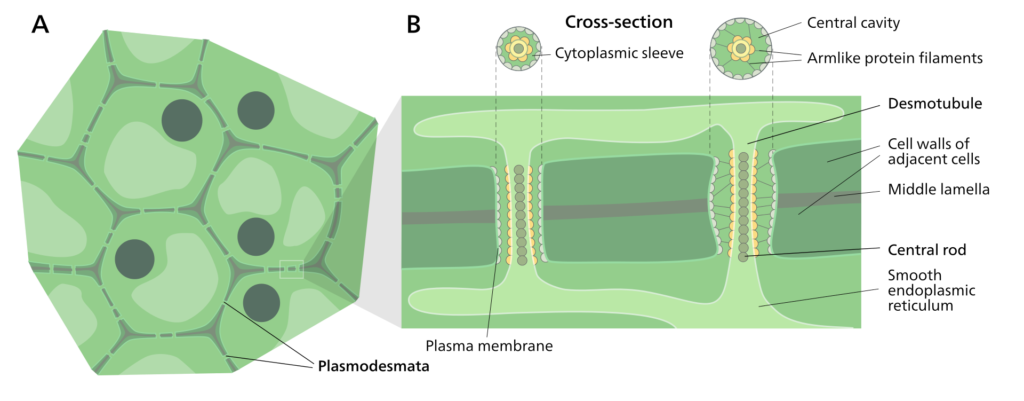
Functions of Plasmodesmata
- Plasmodesmata are the primary site for the communication of two cells. It allows the transfer of molecules like proteins, RNA, and viral genomes.
Plastids
Plastids are double membrane-bound structures present in plants and other eukaryotes involved in the synthesis and storage of food.
Structure of Plastids
- Plastids are usually oval or spherical with an outer and an inner membrane between which lies the intermembrane space.
- The inner membrane enclosed a matrix called stroma that contains small structures called grana.
- Each granum consists of several sac-like thylakoids piled one on the other and connected by stroma lamellae.
- Plastids contain DNA and RNA that allows it to synthesize necessary proteins for different processes.

Functions of Plastids
- Chloroplasts are the center for many metabolic activities, including photosynthesis as it contains enzymes and other components required for it.
- They are also involved in the storage of food, primarily starch.
Ribosomes
Ribosomes are ribonucleoproteins containing equal parts RNA and proteins along with an array of other essential components required for protein synthesis. In prokaryotes, they exist freely while in eukaryotes, they are found either free or attached to the endoplasmic reticulum.
Structure of Ribosomes
- The ribonucleoprotein consists of two subunits.
- In the case of prokaryotic cells, the ribosomes are of the 70S with the larger subunit of 50S and the smaller one of 30S.
- Eukaryotic cells have 80S ribosomes with 60S larger subunit and 40S smaller subunit.
- Ribosomes are short-lived as after the protein synthesis, the subunits split up and can be either reused or remain broken up.
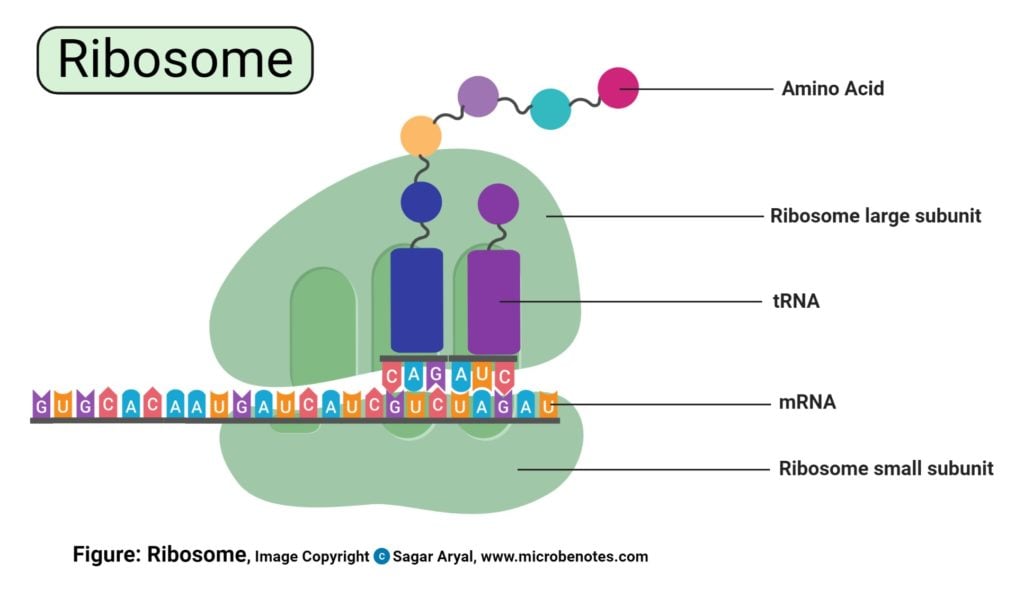
Functions of Ribosomes
- Ribosomes are the site of biological protein synthesis in all living organisms.
- They arrange the amino acids in the order indicated by tRNA and assist in protein synthesis.
Storage granules
Storage granules are membrane-bound organelles, also called zymogen granules storing cells’ energy reserve and other metabolites.
Structure of Storage granules
- These granules are surrounded by a lipid bilayer and are composed mostly of phosphorus and oxygen.
- The components inside these storage granules depend on their location in the body with some even containing degradative enzymes yet to participate in digestive activities.
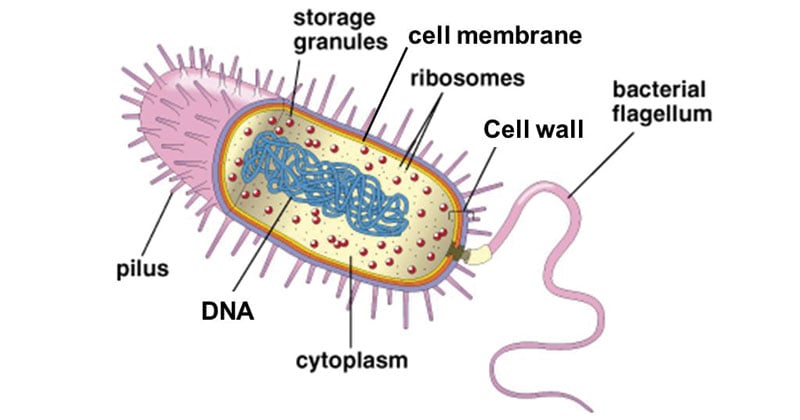
Figure: Diagram of Storage Granules. Image Source: Slide Player
Functions of Storage granules
- Many prokaryotes and eukaryotes store nutrients and reserves in the form of storage granules in the cytoplasm.
- Sulfur granules are characteristic of prokaryotes that utilize hydrogen sulfide as a source of energy.
Vacuole
Vacuoles are membrane-bound structures varying in size in cells of different organisms.
Structure of Vacuoles
- The vacuole is surrounded by a membrane called tonoplast, which encloses fluid containing inorganic materials like water and organic materials like nutrients and even enzymes.
- These are formed by the fusion of various vesicles, so vacuoles are very similar to vesicles in structure.
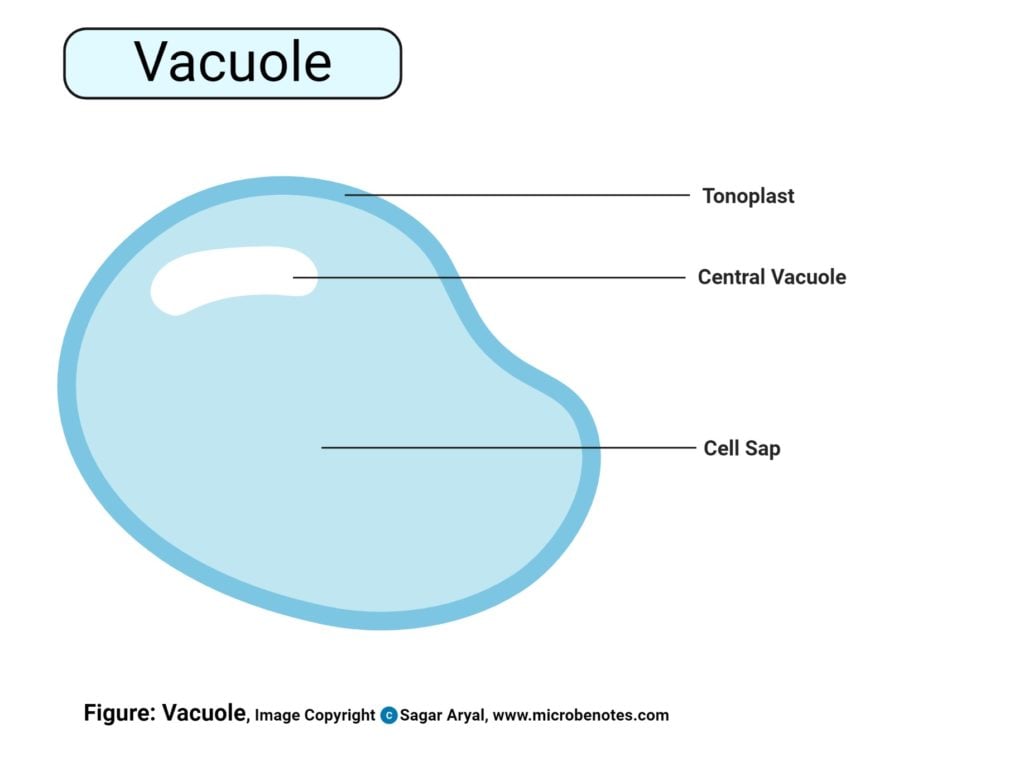
Functions Vacuoles
- Vacuoles act as a storage for nutrients as well as waste materials to protect the cell from toxicity.
- They have an essential function of homeostasis as it allows the balance of pH of the cell by influx and outflow of H+ ions to the cytoplasm.
- Vacuoles contain enzymes that play an important role in different metabolic processes.
Vesicles
Vesicles are structures present inside the cell that are either formed naturally during processes like exocytosis, endocytosis, or transport of materials throughout the cell, or they might form artificially, which are called liposomes. There are different types of vesicles like vacuoles, secretory, and transport vesicles based on their function
Structure of Vesicles
- A vesicle is a structure containing liquid or cytosol which is enclosed by a lipid bilayer.
- The outer layer enclosing the liquid is called a lamellar phase which is similar to the plasma membrane. One end of the lipid bilayer it hydrophobic whereas the other end is hydrophilic.
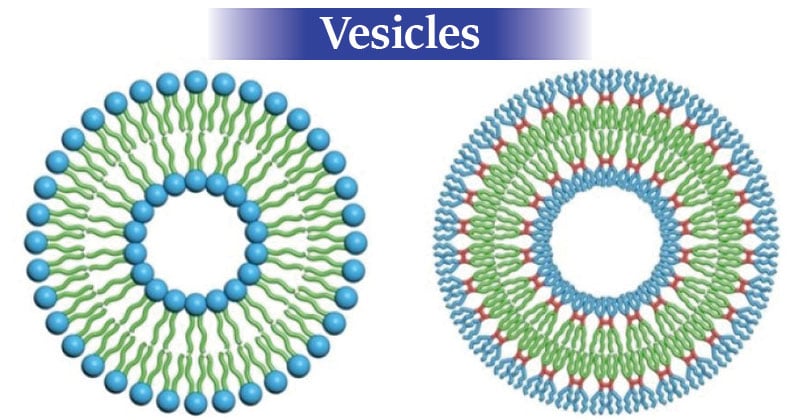
Figure: A liposome (left) and dendrimersome. The blue parts of their molecules are hydrophilic, the green parts are hydrophobic. Credit: Image courtesy of University of Pennsylvania
Functions of Vesicles
- Vesicles facilitate the storage and transport of materials in and outside the cell. It even allows the exchange of molecules between two cells.
- Because vesicles are enclosed inside a lipid bilayer, vesicles also function in metabolism and enzyme storage.
- They allow temporary storage of food and also control the buoyancy of the cell.
References
- https://bscb.org/learning-resources/softcell-e-learning/golgi-apparatus/
- https://micro.magnet.fsu.edu/cells/lysosomes/lysosomes.html
- https://www.britannica.com/science/mitochondrion
- https://www.khanacademy.org/science/biology/structure-of-a-cell/prokaryotic-and-eukaryotic-cells/a/plasma-membrane-and-cytoplasm
- https://www.khanacademy.org/science/biology/structure-of-a-cell/prokaryotic-and-eukaryotic-cells/a/nucleus-and-ribosomes
- https://www.ncbi.nlm.nih.gov/books/NBK9889/
- https://www.ncbi.nlm.nih.gov/books/NBK9896/
- https://www.ncbi.nlm.nih.gov/books/NBK9928/
- http://www.biology4kids.com/files/cell_vacuole.html
- http://cytochemistry.net/cell-biology/intermediate_filaments.htm
- https://www.sciencedirect.com/topics/agricultural-and-biological-sciences/plasmodesmata
- https://biologydictionary.net/vesicle/
- https://www.britannica.com/science/microvilli
- Luby-Phelps K. The physical chemistry of cytoplasm and its influence on cell function: an update. Biol. Cell. 2013;24:2593–2596.
- Lavanya, P. (2005). Cell and Molecular Biology, Rastogi Publications.
- Verma, P. S., & Agrawal, V. K. (2006). Cell Biology, Genetics, Molecular Biology, Evolution & Ecology (1 ed.). S .Chand and company Ltd.
- Images created using biorender.com

My Teacher Will Like This Page when She Will See It Because Its So Helpful.
Microvilli act as an anchoring agent in white blood cells and in sperms during fertilization.
…. i didnt understand this line… can u explain properly?
good style of writing and explanations
SUPPORTED WITH PICTURE
Clear , authentic and genuine description very helpful to students and teachers as well.
Nice to see to it.
Again and again.
much helpful thanks
So helpful thank you
I find this site very helpful and educative
It is an Excellent site, very much helpful for the students who preparing for NEET.
Amazing 😻
Wow this is really good explanation
Thank you
interesting….. 🙂
This is good job done I love it
Well and detailed notes.
The explanations are simple and understandable. Thank You
I the website it gives better and relevant information.
very helpful notes
Thank you for this indepth explanation. Very helpful.
it is more than some cells
its alot of cell organelles it has so comment as just cells and cells membrance.
Well structured and articulated notes.